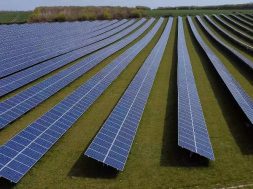
Sunpreme Plans Texas Cell and Module Facility in 2019
The first cell manufacturing announcement since the Trump administration imposed tariffs.
Sunpreme, a California-based solar cell and bifacial panel maker, plans to open a Texas manufacturing facility in 2019.
Envisioned in two phases, the plant’s capacity will eventually ramp to 400 megawatts of production. Sunpreme expects the first 136-megawatt phase to come online early next year with an additional 260 megawatts added later that year, depending on funding streams. According to Wood Mackenzie Power & Renewables, it’s the first investment in added U.S. cell capacity following the Section 201 tariff announcement.
Sunpreme presented a trio of reasons for the decision: its major customer base in the U.S., a 2016 SunShot grant to develop low-cost copper metallization — which at the time the company said would allow it “to bring profitable, high-value solar manufacturing back to the United States in the very near future” — and yes, tariffs.
“We are trying to build the product for allowing us to have zero tariffs,” said Surinder Bedi, Sunpreme’s executive vice president of global business development, system products and quality and reliability, at Solar Power International. “It has been a very significant impact. […] That’s one of the important motivations.”
Sunpreme is a small producer of premium, high-efficiency cells and makes only bifacial panels. It currently has one manufacturing facility in China where it makes its N-type mono cells. The company has been subject to both anti-dumping and countervailing duties and Section 201 tariffs.
It assembles modules in the Philippines, and as of a month ago, in California, through an original equipment manufacturer. According to Bedi, about 60 to 65 percent of assembly is in the U.S.
Manufacturing cells in the U.S. will allow the company to circumvent the 2.5-gigawatt annual cell quota built into the Trump administration’s Section 201 decision.
“If you look at our company today, our product says ‘Designed in California,’ and now we’re going to say ‘Assembled in California’ as well,” Bedi said. “Then, we will say, ‘Made in the U.S.’ — completely.”
More and more companies are interested in bifacial technology, but Sunpreme has been at the forefront of the technology for years. According to Sunpreme, its product’s level of bifaciality is between 93 to 99 percent, though a bifacial installation’s output depends on several variables.
After the new plant comes online, Bedi said products sold to the U.S. market will be made entirely in America. Those cells and modules could also be exported to Sunpreme’s other markets depending on demand. It currently sells to 28 countries.
Jade Jones, a senior solar analyst at Wood Mackenzie, said the timeline is speedy. Other manufacturers that have announced U.S. facilities in the wake of Section 201 tariffs are still ramping plants months after they were announced.
Since the tariff announcement in January, FirstSolar, JinkoSolar, Hanwha Q Cells, LG and SunPower have all promised investments in U.S. manufacturing. Only Canadian-based Heliene has brought a plant online. That company made the decision to manufacture in the U.S. prior to the administration’s announcement.
Sunpreme has not yet settled on a facility. But the strategy is a natural outgrowth of the company’s efforts to serve the U.S., where 65 to 70 percent of its customer base is located. Much of its business is focused on the commercial and industrial market.
“We are bringing in the cells and trying to build the product in this country now, so it leads into building our own cell and module factory in this country,” said Bedi. “Our intention is to build in this country both cell and module at the same cost as we are trying to build in China. It’s going to be challenging, but that’s the strategy, that’s the target.”
















